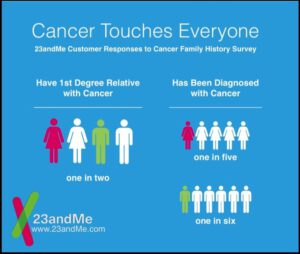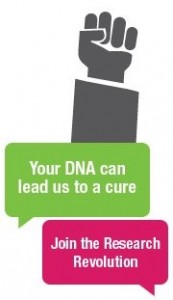By Meghan Mullins
Before joining 23andMe, I worked at a more traditional genetic research lab. Like virtually all research centers, we didn’t return genetic results to our research participants.

I occasionally thought about what that meant, that I knew more about an anonymous stranger’s DNA than he or she ever would. These people had variants that scientists had never seen before, but the research participants would never learn of this.
Last fall I moved back to the Bay Area and joined the research team at 23andMe. I suddenly found myself in a completely different environment — not only do we return data to research participants, but they play an active role in the research process. 23andMe partners with patients who work side-by-side with us to dramatically accelerate genetic discovery.
We recently launched a 23andMe Research Ambassador program, where research participants have volunteered to help more formally spread awareness of and expand our Sarcoma, Myeloproliferative Neoplasms (MPN), and Parkinson’s research initiatives. In honor of National Cancer Research Awareness month, we asked some of our newly minted Sarcoma and MPN Ambassadors to share their cancer stories.
Each of these ambassadors – Tracy, Ruth Ann, Natalie, Greg, and Cheryl-Anne – describe the uncertainty he or she faced when being diagnosed with a rare cancer. Tracy says her doctors at first did not know if her tumor “was a chondrosarcoma or a chordoma. Apparently [it was] one in a million.” For many, the simple lack of information available feels like hitting a wall. Ruth Ann joined our Sarcoma Community because “having been so discouraged in my own journey with the lack of information about sarcomas, I was more than willing to sign up to start a project that might provide some real answers.”

– Do you have sarcoma, or know someone who does? Learn how to join our Sarcoma research community today.
– Do you have an MPN, or know someone who does? Learn how to join our MPN research initiative today.
Cheryl-Anne agrees, saying that “the more we know, the more we will be able to make sure the right patient gets the right drug at the right dose at the right time.” A sense of community and support also drew many to our research initiatives. Greg says that “connecting with others who have a similar interest in fighting sarcoma was my initial motivator in joining 23andMe.” When asked what advice he would give to someone who was just diagnosed, he said to “connect with others who have been in similar situations. Learn from their successes and mind their shortcomings.”
Our research Ambassadors also desire to look at the big picture when studying cancer risk. Greg notes that it’s currently unknown how different risk factors, like “radiation or chemical exposure, a virus or genetic factors,” interact to cause sarcomas. He wants “to help the scientists come closer to solving these questions.” Ruth Ann adds that “since it is so rare, there have to be many more factors than genetics alone that affect the occurrence of sarcoma. But, that doesn’t mean there isn’t a genetic component.” 23andMe wants to learn more about those different factors, too, so we combine our genetic data with survey responses to study all aspects of cancer risk.
Cheryl-Anne has enjoyed exploring her own 23andMe data, saying that “it is fascinating to learn about myself, my own biology. This is me, my chromosomes, my DNA, and it helps me to make better choices for myself.” Natalie’s advice to someone else with an MPN is to “get a 23andMe spit kit. Find out your risks, and go back to your doctor and share that information. You learn a lot about yourself. . . I am very glad that I went through with that decision.”
Tracy was able “to provide the raw data to a genetic counselor for hereditary cancer testing for a condition called Ollie’s disease, where tumors mutate into sarcomas.” Ruth Ann has “enjoyed filling out the surveys, and getting the results about ordinary things. Who knew there was an asparagus pee gene?” We also make sure to share new discoveries with our research participants who helped us find them. Greg is grateful for 23andMe’s “sincere partnership in making strides to identifying the root cause of this life threatening disease.”
Scientists may have the best in technology and theory at their disposal, but they cannot move forward without research participants who are willing to give their time and energy to scientific pursuit. Natalie hopes that scientists and those with rare disease can “help each other, hand in hand.” I feel so incredibly lucky to interact with these generous individuals on a daily basis, to see their desire to give back so that others do not have to face the fear and uncertainty that they felt.
23andMe is intended for research and educational purposes only. 23andMe’s services are not a substitute for professional medical or diagnostic advice.
Meghan Mullins is a research assistant at 23andMe and works with our Research Communities. Meghan studied Human Biology at Stanford University. She spent a few years studying the genetics of obesity and diabetes in the Pima Indians as part of a NIH Postbaccalureate Intramural Research Training program, and played a key role in a large sequencing project that discovered several variants of interest in the MC4R gene.